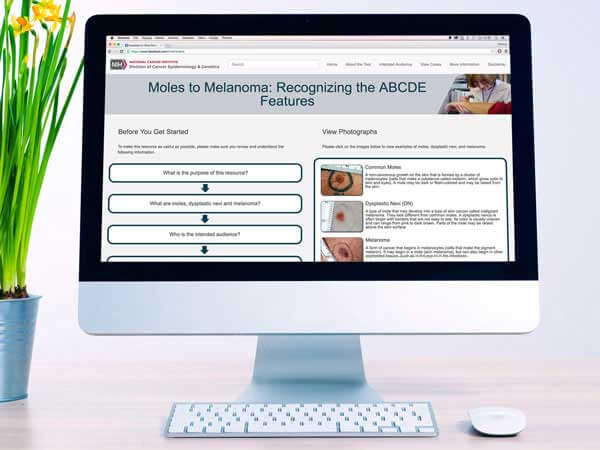Online Tool Helps Users Distinguish Moles from Melanoma
, by NCI Staff
As Melanoma/Skin Cancer Detection and Prevention Month comes to a close and summer begins, NCI has launched a new online tool called Moles to Melanoma: Recognizing the ABCDE Features.
The new tool is intended to help educate the public about the appearance and features of common moles (nevi), which pose no health risk, as well as those of atypical moles (dysplastic nevi), which can increase melanoma risk, and actual melanomas.
Melanoma is among the most common types of cancer in the United States, and the number of new cases has been increasing over the last 40 years. Melanoma is also the most deadly form of skin cancer, leading many public health organizations to stress the importance of early detection. Between 2004 and 2010, for example, 98% of patients diagnosed with melanoma that had not spread beyond the initial location on the skin survived 5 years or longer.
For more than four decades, researchers from NCI’s Division of Cancer Epidemiology and Genetics (DCEG) have collected photographs of 29 different pigmented skin lesions from participants enrolled in the NCI Familial Melanoma Study.
These photos form the basis for the Moles to Melanoma tool, explained Margaret Tucker, M.D., the study's principal investigator. The photos are presented as a series of cases that show changes in individual pigmented lesions over time, including examples of small moles that developed over time into melanomas.
The tool also describes the different appearances of moles, dysplastic nevi, and melanomas, using the ABCDE rule. Dermatologists and other physicians use the ABCDE rule to assess a mole or lesion’s asymmetry, border, color, diameter, and evolving or changing appearance.
“Melanomas and lesions suspicious for melanoma vary widely in appearance,” Dr. Tucker said. “This tool will help people distinguish normal changes in pigmented lesions from those that should be examined by a health care provider.
“The photographs used in the tool show moles and melanomas from trial participants, who are primarily white,” she added. “But it’s important to be aware that anyone can get skin cancer, regardless of their skin color.”
With the summer months approaching, Dr. Tucker stressed that there are proven ways to reduce your risk of skin cancer, and this new tool can help.
“Protect yourself from the sun, avoid tanning beds, check your skin monthly, and be aware of changes in your skin, especially in pigmented lesions,” she said.
